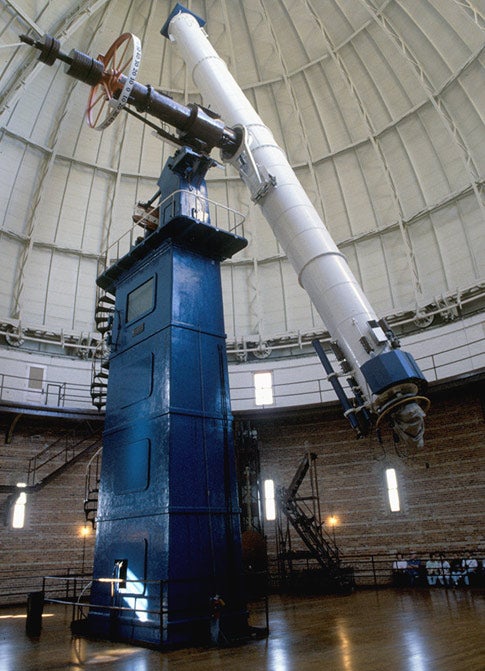General planetary observations don’t require ultrahigh magnifications. Astronomers used them only when they were observing tiny objects.
Seldom, however, are these giant refractors pointed at the Moon. It’s just too bright.
Big telescopes have several advantages over their smaller counterparts. First, the bigger the scope, the more light it collects, which makes images brighter. Second, a telescope’s resolution — how clearly it shows the image — depends on two factors: aperture (the size of the telescope’s lens or mirror) and seeing (atmospheric steadiness). So, even if the magnification used by some 19th-century professionals equals what a modern-day amateur astronomer might employ, the view through the larger scope would show finer details.
As an example, American astronomer Edward Emerson Barnard (1857–1923) discovered Amalthea, the fifth satellite of Jupiter, on September 9, 1892, using an eyepiece that yielded 520x on the 36-inch Lick Observatory refractor. I have viewed many objects through 8- to 12-inch telescopes at this magnification or higher, but through none of those scopes would I have any chance of observing Amalthea.
Barnard used 1,500x in 1895 to study whether Jupiter’s large moons were oblong. For his research of the asteroids Ceres, Pallas, and Vesta, and Saturn’s moon Titan, he wouldn’t even observe unless the atmosphere would bear 1,000x — enough magnification to show a disk. A few times, he actually observed these objects at 2,600x. Likewise, Barnard observed asteroid Juno at 1,430x and 1,700x to make disk measurements between 0.2″ and 0.26″.
At the USNO in Washington, American astronomer Asaph Hall (1829–1907) studied Saturn through the 26-inch Clark refractor. Hall used four eyepieces that provided magnifications of 390x, 400x, 600x, and 800x, although he used the last one rarely because of the bad seeing over Washington.
In Flagstaff, Arizona, American astronomers Percival Lowell (1855–1916) and William Pickering (1858–1938) preferred magnifications of 440x and 617x while sketching Mars during its 1894 opposition. They used higher powers for tiny measurements (such as the size of the polar cap). They made these observations through an 18-inch telescope. When the 24-inch refractor went into use, Lowell used similar magnifications for later martian observations.
— MICHAEL E. BAKICH, SENIOR EDITOR










